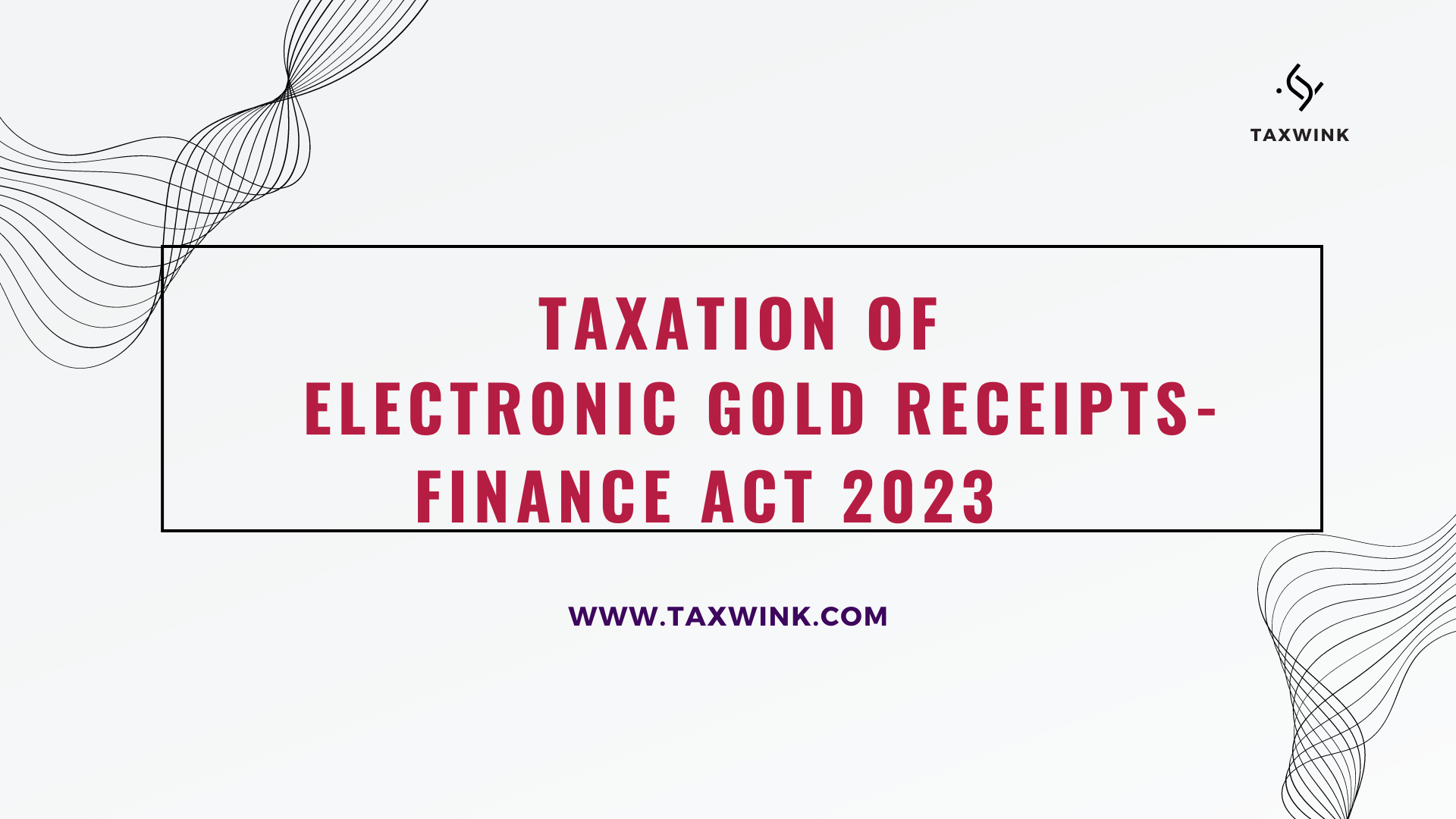Taxation of Electronic Gold Receipts: Finance Act 2023

Introduction:
Gold is considered the most reliable investment by every household in India. Indians are attached to gold also due to cultural and religious values. That is why, India is one of the largest consumers and importers of Gold in the world. The market of gold in India is predominantly unorganized and people prefer keeping gold in physical form with them. Therefore, The Government of India has been striving to regulate the gold market by introducing gold exchanges and digital gold instruments like Gold ETFs, Sovereign Gold Bonds, etc.
Pursuant to the announcement in the Union Budget 2021-22 about Gold Exchange, SEBI has come out with a regulatory framework for spot trading in gold on existing stock exchanges through the instrument of Electronic Gold Receipts (“EGR”). The Government of India vide notification dated 24-12-2021 notified “EGR” as Securities within the meaning of Section 2(h) of the Securities Contract and Regulations Act 1956. This amendment implies that “EGR” will now be treated as securities similar to equity shares or derivatives and thus gold could be held in digital form just like equity shares. Now, any person can convert his/her physical gold into digital gold in the form of EGR.
Background for amendment by Finance Act 2023
Section 45 of the Income Tax provides the basis of chargeability of any income under the head “Capital Gains”. According to Section 45, any gains arising from the transfer of a capital asset in any previous year shall be chargeable to tax under the head “Capital Gains” in the year in which such gains arise.
There are two important elements for chargeability of capital gains:
- There must be a “Capital Asset” &
- There must be a “Transfer” of such capital asset.
Section 2(47) of the Income Tax Act defines the term “Transfer” which includes “sale, exchange and relinquishment of capital assets” in its ambit. A question arises whether the conversion of physical gold into electronic gold falls in the ambit of “Transfer.” The answer to this question is “Yes.”
Therefore, if any person converts his physical gold into electronic gold, this transaction would lead to an exchange of a capital asset with another capital asset resulting in a “transfer”. Thus, the capital gain tax liability would arise on the conversion of physical gold into electronic gold (EGR) even if there is no actual inflow of gains/benefits to that person. The Government taking into consideration this ambiguity and promoting digital gold (EGR) has brought a number of amendments to the Finance Act 2023. The amendments made by Finance Act 2023 intend to make the conversion of physical gold to EGR and vice versa to be tax neutral. Let’s have a glance:
Conversion of physical gold to EGR & vice versa out of the ambit of ‘Transfer’:
Finance Act 2023 provides that the conversion of physical gold to the EGR issued by a SEBI-approved Vault Manager or such EGR back to physical gold shall not be considered a ‘transfer’. As discussed above, for chargeability under the head ‘Capital Gains,’ ‘Transfer’ of a capital asset is a mandatory condition.
Thus, when the conversion of physical gold into EGR and vice versa has been specifically excluded from the definition of ‘Transfer’ itself, there will be no question of taxability under the head ‘Capital Gains’ where a taxpayer converts physical gold into EGR or EGR into physical gold. For this purpose, a new clause (viid) has been inserted in Section 47 of the Income Tax Act as follows:
|
“(viid) any transfer of a capital asset, being conversion of gold into Electronic Gold Receipt issued by a Vault Manager, or conversion of Electronic Gold Receipt into gold. Explanation- For the purposes of this clause, the expressions “Electronic Gold Receipt” and “Vault Manager” shall have the meanings respectively assigned to them in clauses (h) and (l) of sub-regulation (1) of regulation (2) of the Securities and Exchange Board of India (Vault Managers) Regulations 2021 made under the Securities and Exchange Board of India Act, 1992.” |
But it should be kept in mind by the taxpayer that if EGR or physical gold is sold by him for cash or any other consideration, it will continue to fall in the ambit of “Capital Gains” taxation. Therefore, a question arises “How to decide the cost of acquisition where physical gold is converted into EGR and then such EGR is sold and vice versa?”
Cost of Acquisition of gold converted into EGR and vice versa:
For the purpose of determining the cost of acquisition of EGR or gold released against EGR, Section 49(10) has been inserted into the Income Tax Act which provides the following mechanism as below:
|
“(10) Where the capital asset, being-“ (i) an Electronic Gold Receipt issued by a Vault Manager, became the property of the person as consideration of a transfer, referred to in clause (viid) of section 47, the cost of acquisition of the asset for the purposes of the said transfer, shall be deemed to be the cost of gold in the hands of the person in whose name Electronic Gold Receipt is issued; (ii) gold released against an Electronic Gold Receipt, which became the property of the person as consideration for a transfer, referred to in clause (viid) of section 47, the cost of acquisition of the asset for the purposes of the said transfer shall be deemed to be the cost of the Electronic Gold Receipt in the hands of such person.” |
In simple words,
Cost of Acquisition of EGR:
Cost of acquisition of EGR acquired in the conversion of physical gold = Cost of acquisition of physical gold converted into EGR
Cost of Acquisition of gold released against an EGR:
Cost of acquisition of gold released against EGR = Cost of EGR in the hands of such person
For example:
X holds 50 grams of gold which he has acquired at Rs. 50,000. He gets 40 gms. of gold converted into 40 EGR (1 EGR= 1 gm.). He then sold 10 EGR at Rs. 14,000. He reconverts 5 EGR back to physical gold also.
Solution:
- Cost per Gram of physical gold = 50,000/50 = Rs. 1,000
- Therefore, Cost of 1 EGR = Cost of Physical Gold i.e. 1 EGR = Rs. 1,000. Total cost of 40 EGR = 1,000 * 40 = Rs. 40,000
- No Capital gain arises when 40 gms. physical gold is converted into 40 EGR.
- Sales Consideration of 10 EGR = Rs. 14,000
- Cost of acquisition of 10 EGR = 1,000 * 10 = Rs. 10,000
- Capital Gain on sale of EGR = 14,000 – 10,000 = Rs. 4,000
On reconversion of EGR into physical gold, there will be no capital gains. However, the cost of acquisition of gold released against EGR i.e. 5 grams shall be equal to the cost of acquisition of 5 EGR = Rs. 1,000 * 5 = Rs. 5,000.
Period of Holding:
Now the next issue which is quite pertinent for the purpose of calculation of “capital gains” is the ‘period of holding’ of EGR or gold released against EGR. We are aware that for the purpose of considering any capital asset as a long-term capital asset, the minimum holding period is 3 years (with certain exceptions).
Therefore, a question arises as to how will we calculate the period of holding where a taxpayer first converts physical gold into EGR and then sells such EGR or vice versa. For this purpose, a new clause (hi) has been inserted in Explanation (1) of Section 2(42A) of the IT Act to provide that for the purpose of computing capital gains, the holding period of:
- EGR, issued in respect of gold deposited as referred to in proposed Section 47(viid), shall include the period for which the gold was held by the assessee prior to conversion into EGR.
- Gold released in respect of EGR as referred to in Section 47(viid), shall include the period for which such EGR was held by the assessee prior to its conversion into gold.
Example:
X purchased 50 gms. of gold on 01-04-2020 at Rs. 50,000 (Cost per Gram Rs. 1,000). He converts 40 gms. of gold into 40 EGR on 14-04-2022. Out of 40 EGR, he sold 10 EGR on 18-09-2023. Calculate the period of holding.
Solution: For calculating the period of holding of EGR, the holding period of physical gold shall also be included. Therefore, the period of holding for EGR shall be 01-04-2020 to 18-09-2023 i.e. 3 years 5 months and 17 days. In this example, the sale of EGR shall result into a long term capital gain.
Disclaimer: The above article is meant only for educational purposes and does not carry any persuasive value. Therefore, the readers are advised to act in consultation with any professional before applying the information contained in this article. Taxwink is not responsible for any loss or damage caused to any person on account of any information contained in this article.
About Author: The article is contributed by CA Naveen Goyal who is a qualified Chartered Accountant with an experience of over 16 years in the field of Direct & Indirect Taxes. He is a prolific writer with a zeal to share knowledge on various issues pertaining to taxation laws in India. He can be reached at: support@taxwink.com



